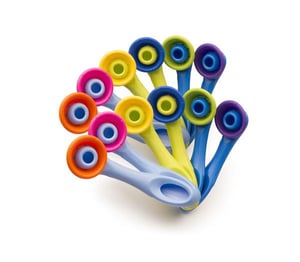How to Use a Whisper Phone to Teach Autistic Children to Read
This resource was created as a supplement for the ARIS® Academic Readiness Intervention System Language Builder complete early autism curriculum, Lesson #161, Expressive Phonics. Download a free copy of the lesson and learn more about the ARIS curriculum.
The Whisper Phone is an important tool for teaching autistic children to read. This simple, low-tech device looks like a phone. As children whisper read, or read aloud, they hear their voices. Using the Whisper Phone helps autistic children learn to read because as they practice reading, they receive immediate auditory feedback that helps them self-monitor and improve their reading skills in areas of speech, pronunciation, fluency, and comprehension. The Whisper Phone can also help autistic children develop confidence in their reading abilities.
What Is Whisper Reading?

Whisper reading is a way to teach autistic children to read. It’s a simple strategy that can be used in schools, therapies, or at home. Phonemes are the individual sounds in a word. As children begin to learn to read, they must read aloud to practice sounding these letters out. This is called phonemic awareness. Once they begin to understand phonemes, children learn to recognize how these individual sounds create a word.
Whisper reading is an important strategy in supporting your child’s development of phonemic awareness. While learning to read, students whisper the words they are sounding out or reading aloud. In addition to speaking the sound, hearing it creates a multisensory approach to learning phonemes.
What Is the Whisper Phone?
The Whisper Phone is a tool used to support whisper reading for your autistic child. It looks like a toy phone and there is also a headset. Like a regular phone, the child holds the Whisper Phone up to their ear and as they speak into it, their voice is amplified and they can listen to themselves read. In addition to reading independently, there are two “receivers” which are connected by a tube, so your child can whisper read with themselves, a peer, teacher, or parent.
Whisper Phones are typically used during reading or phonics lessons, speech therapies, or music classes.
Whisper Phones can support reading fluency in children because they promote phonological awareness. As children sound out letters and full words to themselves, they begin to understand how sounds and letters blend. As children practice their sounds and words and read full sentences while listening to themselves, they can better recognize specific letters, sounds, and phoneme blends they are experiencing difficulty with. Using a Whisper Phone to support reading also builds confidence in children.
Why Does It Help Autistic Children?
The Whisper Phone can help autistic children learn to read. Many autistic children experience challenges with over- or under-stimulation, focusing, auditory processing difficulties, speech delays, and lack of confidence in their reading skills. The Whisper Phone supports development in these areas, allowing children to actively engage in their reading, remain motivated, and self-monitor their practices.
 Unlike being read to or listening to an audiobook, when children read to themselves, they can control the volume of the reading. When autistic children experience over- or under-stimulation in the sounds they hear, for example, this may impact their focus. While readers are paying attention to their voices, their hands also remain busy holding the Whisper Phone.
Unlike being read to or listening to an audiobook, when children read to themselves, they can control the volume of the reading. When autistic children experience over- or under-stimulation in the sounds they hear, for example, this may impact their focus. While readers are paying attention to their voices, their hands also remain busy holding the Whisper Phone.
Many autistic children may experience auditory processing difficulties and delays in speech. Sometimes these are connected. Using a Whisper Phone provides immediate, direct auditory feedback. As children speak sounds and words themselves, they develop the ability to hear single phonemes themselves. The ability to recognize and manipulate phonemes and blended sounds is the beginning of learning to read and speak fluently. While children listen to themselves read and speak, they are more motivated to self-identify and self-correct errors.
Many children lack confidence when it comes to reading. In classroom settings, children may be put on the spot to read aloud to a group and listen to others read aloud, leading to comparisons and possible embarrassment. For emergent readers or children who are especially shy, the Whisper Phone allows an opportunity for them to practice their skills without the added stress of someone listening. Being able to practice, make mistakes, and self-correct can boost confidence in reading for autistic children.
What Does the Research Say About Whisper Reading?
Emergent and early readers start with the foundation of phonemic awareness skills using nonsense words. Children enjoy making up silly words or reading stories by authors such as Dr. Seuss, which contain made-up words. Not having the ability to read yet, these made-up words allow children to practice speaking sounds and sound blends, exploring different combinations they can make. Beginning to say nonsense words and making silly sounds creates the foundation for the manipulation of phonemes later on. Even for children who are unable to read, incorporating a Whisper Phone while they speak “nonsense” allows them to begin hearing the sounds they are creating.
 Often, while children are beginning to learn to read, words are taught in isolation and students are encouraged to "perfect" each phoneme, thus creating a blended word. However, research has consistently shown that this impairs comprehension. When learning words in isolation, students are not given the chance to preview the rest of the sentence for context clues and easily forget what they have just read because their focus is on specific phonemes. Whisper reading allows students to hear themselves read individual words within a whole sentence and monitor their comprehension while reading the whole text and not just individual words.
Often, while children are beginning to learn to read, words are taught in isolation and students are encouraged to "perfect" each phoneme, thus creating a blended word. However, research has consistently shown that this impairs comprehension. When learning words in isolation, students are not given the chance to preview the rest of the sentence for context clues and easily forget what they have just read because their focus is on specific phonemes. Whisper reading allows students to hear themselves read individual words within a whole sentence and monitor their comprehension while reading the whole text and not just individual words.
When students read orally, they are experiencing words in a multisensory approach. Seeing, reading, speaking, pronouncing, and hearing the words create three representations of the word for the student. Whisper Phones heighten this multisensory experience by allowing students to engage their bodies more (holding the phone) and changing the volume, tone, and delivery of their speech.
Learning is most effective when multiple modalities of learning are included: tactile learning (using the body), sight, speaking, and listening, are all incorporated when students engage in whisper reading.
Best Practices for Using the Whisper Phone and Whisper Reading Effectively
-
Find an appropriate reading space.
For autistic children, they must be in a space that is comfortable and not over- or under-stimulating. In the classroom, perhaps your child enjoys reading in a comfortable corner with a blanket and the lights dimmed. Recognize where your child is most comfortable and focused, and recreate this environment in your home. Being in an appropriate space will better motivate your child and help them focus while whisper reading. -
For many children, reading can become a daunting, repetitive chore. It is important to help your child remain excited by reading. Allow them to pick out their own stories, make a field trip to the local library, and introduce them to stories that reflect their interests. They will be more motivated to pick up their Whisper Phone and practice their skills when they are excited about the books they have. Increase motivation.
Increase motivation. -
Make it part of a regular reading routine.
Your child must recognize that using their Whisper Phone isn’t just part of schoolwork. Incorporate it at home, while a parent reads a dinner recipe, sings a song, or when it’s time for a bedtime story. When parents and siblings make whisper reading part of their routine, it will become more normalized for the child to pick up their own Whisper Phone. -
Make it a game.
For many children, especially those who are not yet fluent readers, sitting down with a book is not a preferred activity. You can engage your child with whisper reading in other ways. Make it a game: Pretend to “call” them on the phone and have a conversation! If your autistic child scripts (repeats words or phrases) or echoes words, encourage them to do so into their Whisper Phone to actively listen to themselves. You can also pick out a favorite tune and sing it into your Whisper Phone. Making the Whisper Phone and whisper reading a fun, engaging activity will get your child excited and interested in using the device.
This resource was created as a supplement for the ARIS® Academic Readiness Intervention System Language Builder complete early autism curriculum, Lesson #161, Expressive Phonics. Download a free copy of the lesson and learn more about the ARIS curriculum.
This article is based on the following research:
http://1stgradepandamania.blogspot.com/2017/03/the-wonders-of-whisper-reading.html
https://whispertosuccess.wordpress.com/why-use-a-whisper-phone/
https://www.learning-loft.com/blogs/learning-loft-blog/what-is-a-whisper-phone
https://ila.onlinelibrary.wiley.com/doi/abs/10.1598/RT.58.8.1
https://www-sciencedirect-com.ezproxyles.flo.org/science/article/pii/S0891422220301335?via%3Dihub





